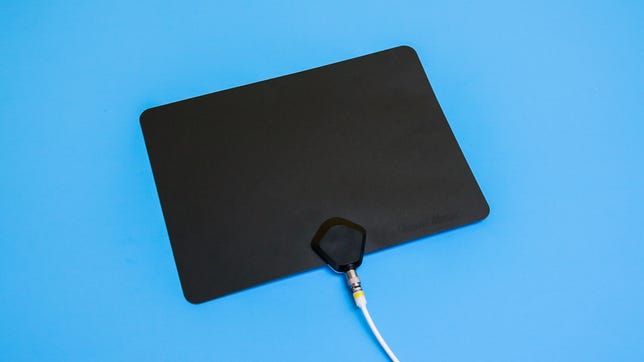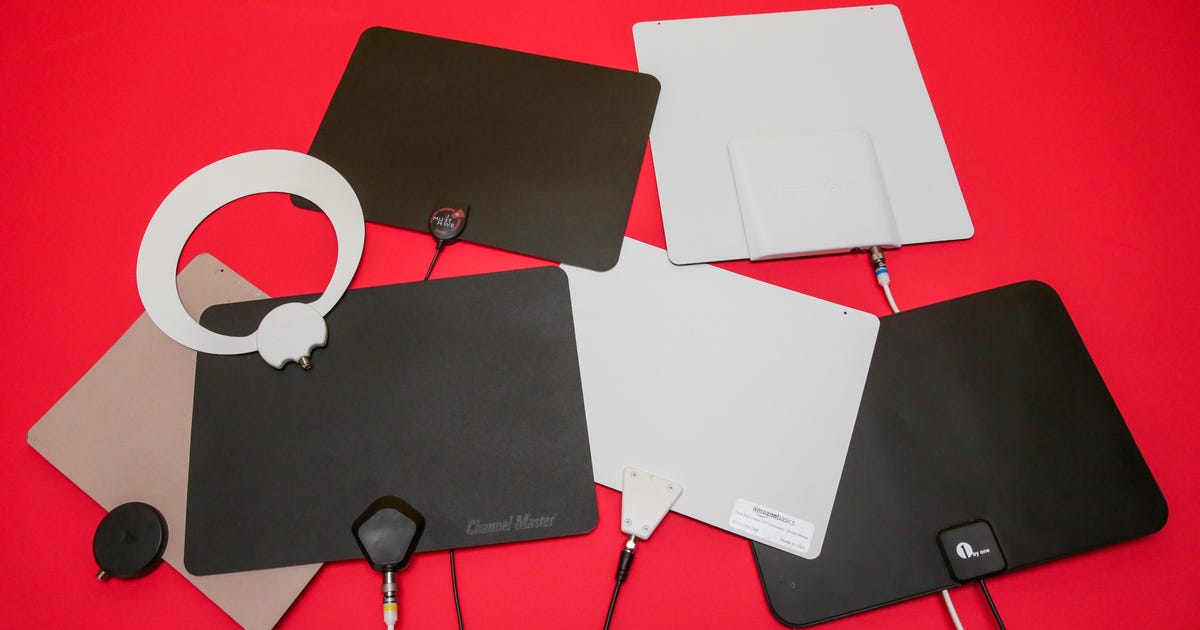
TV can rack up quite the bill, no matter how you get it. Whether you subscribe to a live TV streaming service or use a satellite dish or cable provider, that connection can cost you an arm and a leg every month. Sure, the hundreds of channels are appealing to some, but if you’re someone who doesn’t watch much TV and would like to save some money, it might be a good idea to finally cut the cord.
A TV antenna can help with that. Yep, TV antennas still exist, and if you’re located in a city apartment or somewhere else with a good signal, you’re just one antenna away from free access to popular TV shows, movies, specials and sports.
An over-the-air, or OTA, antenna is great for live events such as sports and the evening news. Depending on where you live and your signal reception capabilities, you can watch anything on NBC, Fox, ABC, CBS, PBS and some other channels like MyNetworkTV and The CW. While a roof-mounted television antenna or outdoor TV antenna would do the job, you can add an indoor antenna to your TV’s built-in tuner for as little as $20 shipped.
If you’re really serious about cutting the cord, check out our Streaming TV Insider for even more tips.
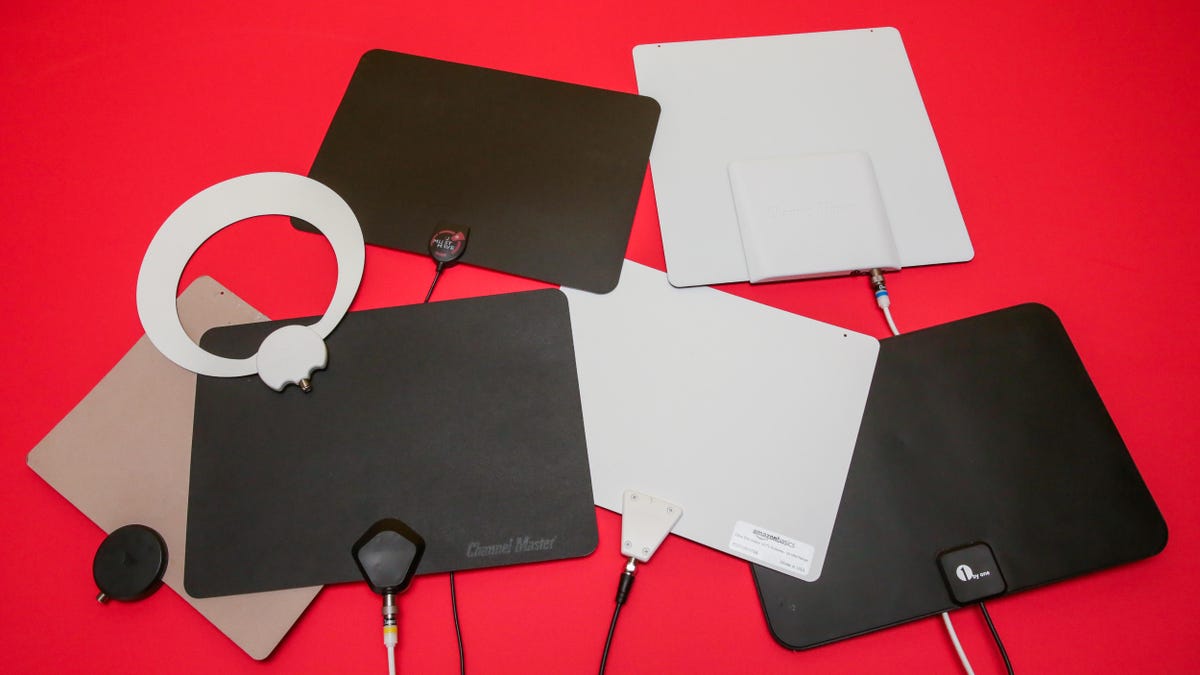
Sarah Tew/CNET
The downside is that in some places, the TV signal of some channels is spotty or nonexistent due to either your proximity, or lack thereof, to a broadcast tower or to obstructions that break up the signal.
Unlike a live TV streaming service, OTA TV is usually restricted to a single television, and the broadcast signal from an OTA TV antenna won’t work on phones or other devices. Unless, that is, you kick it up a notch with an OTA DVR that has networking capabilities.
The best TV antennas we tested
Sarah Tew/CNET
- Detachable coaxial cable? Yes
- Number of channels: 50 in Manhattan, 61 in New Jersey
- Number of watchable channels: 9 out of 13 checked, both locations
The Flatenna 35 has been upgraded with a removable antenna since our original test. It seems that signal performance has also improved — it’s now the best of our seven models at pulling in channels, beating our previous recommendation, the Antennas Direct ClearStream Eclipse. This Flat antenna is great for those who are not capable of installing an outdoor antenna.
And yes, the best TV antenna is just $20 (including shipping) from Channel Master’s website. (It can be called either the Flatenna 35 or Duo depending on where you buy it from.) Best TV channels reception and low price? We have a winner.
Sarah Tew/CNET
- Detachable coaxial cable? Yes
- Number of channels: 39 in Manhattan, 65 in New Jersey
- Number of watchable channels: 9 out of 13 checked, both locations
Maybe you’ve tried the Flatenna with so-so results and want to give it another shot. The Antennas Direct Eclipse won our original comparison and performed very well again this time around at receiving a broadcast signal for many TV channels.
With its ankh-shaped and multidirectional reversible compact design, the ClearStream antenna is definitely unique. This multi-directional antenna comes with sticky tabs for attaching it to your window, which is handy. And if you need more signal oomph, there’s a $20 antenna amplifier available as well.
Best antennas compared
| Price | No. of channels (Manhattan) | No. of channels (NJ) | No. of watchable channels (out of 13) | |
|---|---|---|---|---|
| Channel Master Flatenna 35 | $20 | 50 | 61 | 9 |
| AmazonBasics Ultra Thin Indoor TV Antenna (discontinued) | $21 | 41 | 64 | 8 |
| Antennas Direct ClearStream Eclipse | $30 | 39 | 65 | 9 |
| 1byOne Upgraded 2019 Digital Amplified Indoor HD TV Antenna | $28 | 34 | 49 | 6 |
| Mohu ReLeaf (discontinued) | $30 | 29 | 66 | 6 |
| U Must Have Amplified HD Digital TV Antenna (currently unavailable) | $29 | 28 | 62 | 6 |
| Channel Master Smartenna Plus (discontinued) | $49 | 31 | 53 | 5 |
Other TV antennas we tested
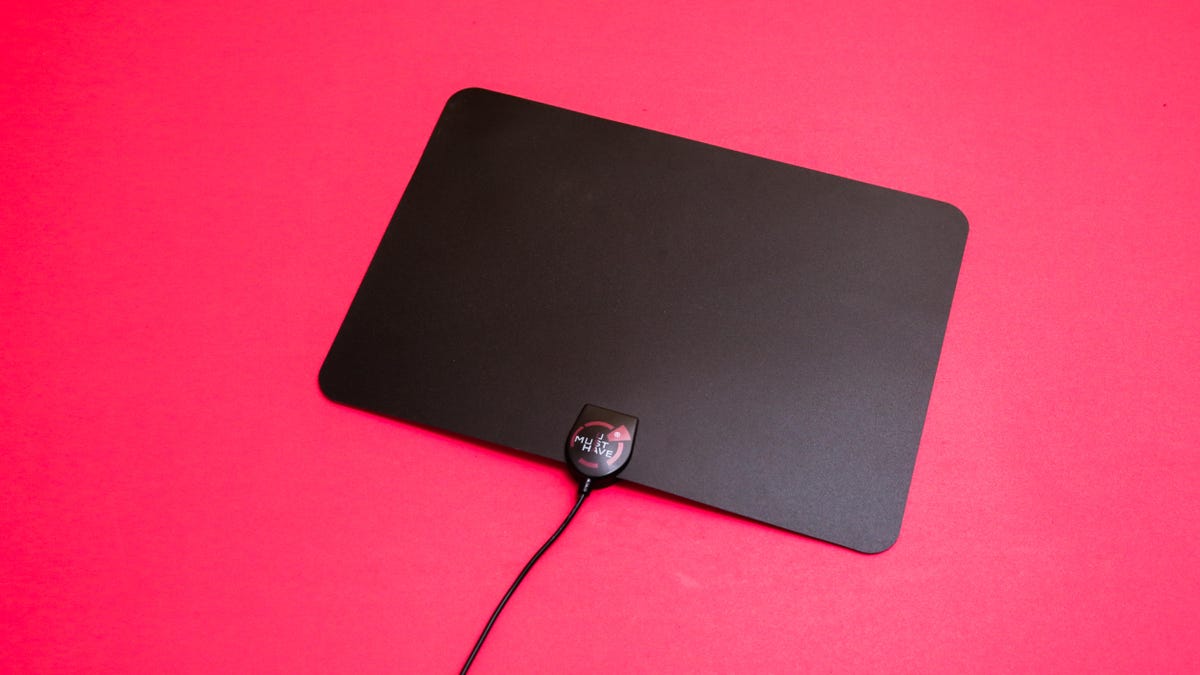
The U Must Have Amplified HD Digital TV Antenna.
Sarah Tew/CNET
- 1byOne Indoor Amplified HDTV Antenna: The 1byOne is one of two antennas in this list with a nonremovable coax cable, and at only 10 feet long, it may not work in some rooms where it cannot pick up a very weak signal. The black plastic feels a little cheap compared with the others, though the HD antenna model does come with a powered gain amplifier. It was toward the bottom of the pack in terms of signal performance, but this indoor HDTV antenna was the only television antenna to pick up CBS from a TV tower at our Manhattan location (see below for details). It is a long-range antenna that receives TV signals up to 200 miles. The current price is cheaper than the others, but in our book the Channel Master Flatenna is the better bet.
- U Must Have Amplified HD Digital TV Antenna (currently unavailable): The U Must Have amplified antenna comes with a sticky pad on the back and a relatively long, though nonremovable, lead at 18 feet. The included amplifier gives the antenna some flexibility and the product feels more solidly made overall than the 1byOne, though they performed similarly.
How we test TV antennas
We tested seven different indoor antennas with prices ranging from $10 to $90 (all much less than the most basic cable TV). The best TV antennas were able to pull in more channels than the others and delivered stronger, clearer TV signals, even on “problem” channels. Here are the seven TV antennas we originally looked at:
- Channel Master Flatenna 35 ($20)
- AmazonBasics Ultra Thin Indoor TV Antenna ($20, out of stock)
- 1byOne Upgraded Digital Amplified Indoor HD TV Antenna ($21)
- Antennas Direct ClearStream Eclipse ($45)
- Mohu ReLeaf ($30, discontinued)
- Channel Master Smartenna Plus ($49, discontinued)
- U Must Have Amplified High Definition Digital TV Antenna ($29, currently unavailable)
Much like real estate, how well a TV antenna works is based on location, location and location.
We tested the antennas in two main locations: in midtown Manhattan just a half-mile from the broadcast antennas on the Empire State Building — albeit obscured by other buildings — and in suburban New Jersey, 9 miles from the closest broadcast towers. Depending on your location, you might receive broadcasts from multiple antennas. Hills or large buildings in the way will have an effect on frequency range and reception of TV channels.
We situated each antenna in the same spot and connected it to the Channel Master DVR Plus, which gives signal strength data as well as a total channel count. We used two different metrics to determine which TV antenna performed best. The first was a raw measure of the number of channels it could detect, while the second involved a number of predetermined “problem channels.” For these, we consulted a list of channels culled from various forums, for both testing areas, and gauged how well the antennas pulled in each channel.
Our list of “problem” channels in Manhattan was WABC 7.1 (ABC), WNET 13.1 (PBS), WPIX 11.1 (CW — Manhattan only) and WNJB 58.1 (PBS — NJ only). In addition we added popular channels CBS 2.1, WNBC 4 (NBC), and WNYW 5 (Fox).
While the results will vary depending on where you live and how far you are from TV towers, we found that the best-performing models received more of the most popular channels as well as local channels and additional radio broadcasts and Spanish-language stations.
Most of the TV antennas are based on the same rectangular design, but there was one important consideration: the cable. Did the antenna have a long, high-performance coaxial cable or, even better, a detachable one? You’ll be sticking one of these in your window, which could be a long way from your TV, so longer is better.
It’s worth noting that some of these antennas — the 1byOne and the Channel Master Smartenna Plus — include gain-boosting amplifiers. While the 1byOne will also work without the amp attached, the Channel Master won’t. Based on our experiences in a number of locations, however, amplifiers offer a wildly unpredictable signal strength benefit. If you can’t get TV reception with an indoor antenna, a gain amp may not actually help you, and in other cases, it could make your reception worse by overloading channels that already have a strong signal.
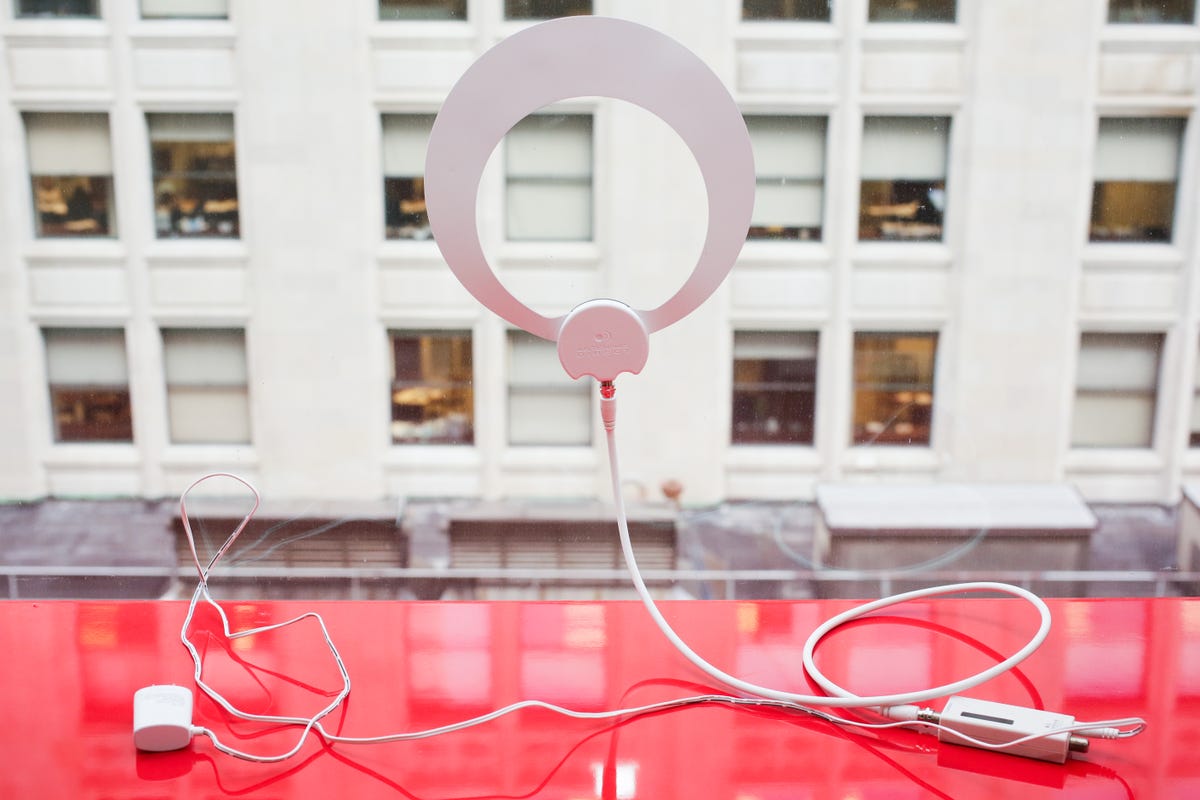
Several antennas in our list include a powered amplifier, but use thoughtfully, as these may actually make a strong signal worse.
Sarah Tew/CNET
TV Antenna FAQs
Do I need an antenna for a smart TV?
The main difference between a television and a monitor is that a TV has an OTA tuner onboard, even if most people never use it. The advent of smart TV means that cord-cutters can now connect directly to the internet and get on-demand streaming as well as live TV. This is usually at extra cost, while an antenna can receive signals without an internet connection. So, no, you don’t need an antenna to use smart TV, but the two do complement each other very well.
Do indoor antennas really work?
Depending on where you live, an indoor antenna can work really well, or not at all. If you live in the middle of a city, it’s likely you’re very close to a broadcast antenna. However, if you live a little further out then you may not be receiving the strongest signals and checking digital TV coverage maps first may help you somewhat.
Correspondingly, if you do live in a poor coverage area, with weak signals, an indoor antenna may not be for you. We tried using the antennas at a semi-urban location in New York State’s Hudson Valley miles from the city and none of them worked at all, even the signal-boosting Smartenna. That’s why it’s best to test the signal strength waters with a cheap antenna first, instead of spending a hundred bucks on something that might not work in your location.
Will my antenna work with ATSC 3.0 or NextGen TV?
ATSC 3.0, also known as NextGen TV, is the next evolution of OTA broadcasts, and it promises higher resolutions, enhanced audio and interactivity. While these NextGen TV features are still a ways off — in 2022 the service is in the process of rolling out — the good news is that it’s designed to be backwards compatible with the existing ATSC. So yes, your existing antenna will still work, though you will need an ATSC 3.0 compatible tuner or TV, and an active internet connection for any interactive or on-demand features.
How do you install an indoor antenna?
Most contemporary antennas include some form of adhesive to attach them to your wall or window. If for some reason they lack this option you could try packing tape or poster putty instead.
When you install it, you will definitely need to experiment with the placement. A wall may actually be better than a window, depending on the orientation of your living area. Also, if possible, keep the antenna away from magnetic metals such as security bars or the like since they can interfere with your signal strength.
If you buy a model with a short, captive lead like the 1byOne, be aware that you may need to buy a male-female extension lead, and more coaxial cable, to get it to reach your equipment. For more on installing an antenna check out our complete guide and video.


